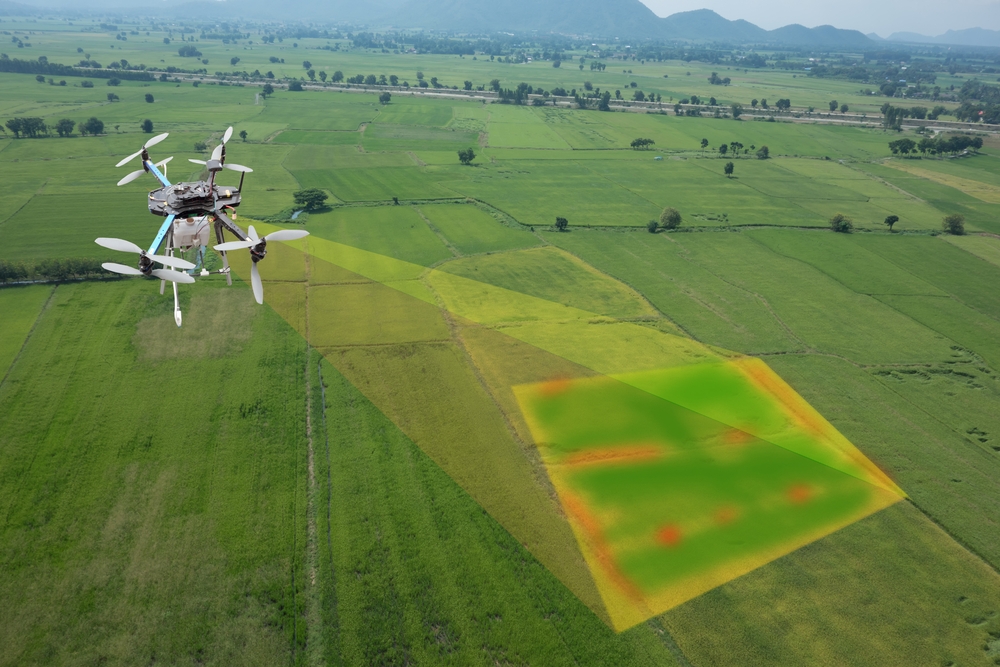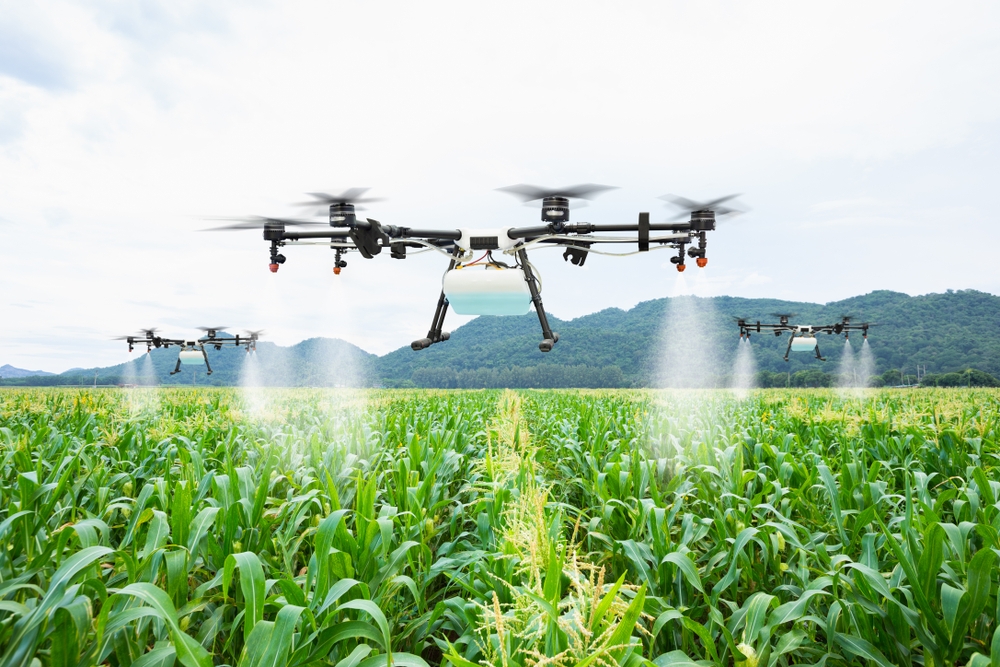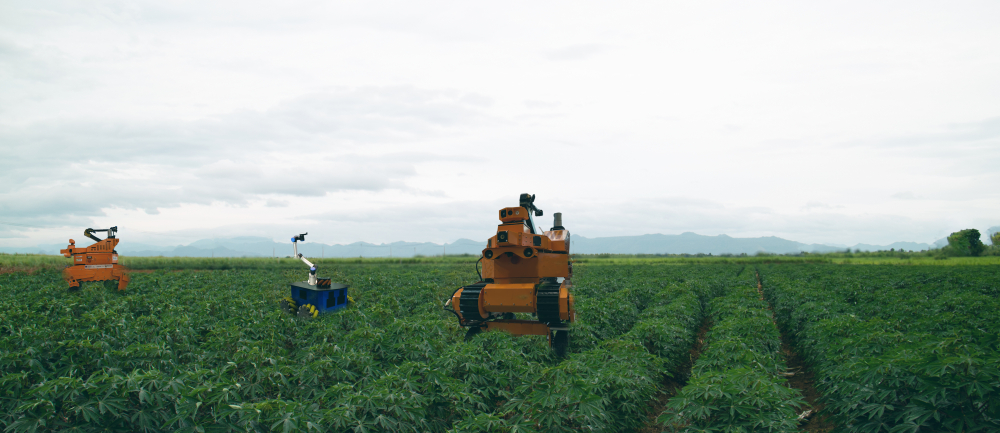April 20-24, Birmingham
Robotics & Market Insights
Agricultural Robots: A Revolutionary Tool For Farmers Worldwide
Agriculture has become increasingly mechanized and automated since the industrial revolution. Artificial Intelligence brings this automation to an even higher level. The use of AI intersects what is now called “precision agriculture.” It is all about reducing inputs such as fertilizer, pesticides, herbicides, and water while increasing yields.
The worldwide annual market for agricultural robots was estimated to be USD 24.5 billion in 2021. It was projected to grow to USD 74.5 billion in 2024, according to a report published on Statista.
This article explores agricultural robots through the following topics:
- Aerial Imaging Robots
- Seeding and Spraying Robots
- Fruit and Vegetable Harvesting Robots
- Autonomous Mobile Robots (AMRs) for Nurseries, Orchards, and Greenhouses
- Weeding Robots
- Robotic Greenhouses
Aerial Imaging Robots

Using aerial drones to inspect crops from the air is well established. Aerial imaging produces valuable insights into crop health and soil conditions. The accepted way to monitor crop growth is to use normalized difference vegetation index (NDVI) maps. But is not just a question of passively examining the data. The NDVI data can be downloaded to tractors. Smart farm equipment uses the data to control the application of fertilizers.
There is a robust market for aerial drones for agriculture with many options from which to choose.
Here are some of the considerations when purchasing an aerial drone for agriculture.
Types of Aerial Drones for Agriculture
There are three main types of unmanned aerial vehicles (UAVs) used in agriculture.
Fixed-Wing Drones
A fixed-wing drone has wings like an airplane and often only one or two propellers. Such a drone can stay aloft for longer than rotary-wing types. Long flight time is an advantage for today's vast farms. But they need a smooth strip for takeoff and landing and are more difficult to pilot than copters.
Rotary Wing Drones
Rotary wing drones have multiple rotors with blades like helicopters. The most common configurations feature four rotors (quadcopters) or six rotors. Some drones have many more. Rotary wing drones are easier to control than fixed-wing. Because they can take off and land vertically, they do not need landing strips. Rotary wing drones are usually less expensive than fixed-wing models.
Hybrid Drones
Hybrid drones take off vertically and then can switch to a gliding mode while in flight. They therefore combine the advantages of the other two kinds of drones. Hybrid drones promise the longer flight time of the fixed wing drone and the ease of use of the rotary-wing types. However, hybrid drones are more complex, heavier, and more expensive. The technology is also not as mature as for the other two types.
Types of Sensors Used in Agricultural Drones
The type of sensors the drone carries will determine the information gathered. Here are some of the most common types of sensors.
RGB Cameras
An RGB sensor is also called a true-color camera. RGB sensors are so named because they detect light in three components: Red, Green, and Blue. The images produced by RGB cameras are like human vision.
Multispectral Cameras
As the name implies, multispectral sensors detect light in a band of frequencies. Two especially useful bands of frequencies for agriculture include infrared and the “red edge band.” Healthy plants reflect infrared light more strongly than stressed plants. The red-edge band is between the red band and the infrared. Light reflected in the red edge band is also strongly correlated with plant health.
Thermal
Thermal cameras help in detecting plant stress – especially water stress.
LiDAR
Light Detection and Ranging sensors are heavier and more expensive than the other three types of sensors mentioned above. They are used to map terrain elevations and are more often deployed on manned aircraft.
Purchase vs. Subscription Service
A farmer need not purchase an aerial drone to gain its benefits. You also have the option to contract with an agency that provides aerial imaging as a service. You can subscribe to a service that will periodically perform the imaging for you. Subscribing to a service may be an attractive option for those who would rather not take the time to learn to operate the new technology.
Request offers of aerial imaging drones for agriculture
Seeding and Spraying Robots

Drones for seeding and spraying are still a new thing, but they are commercially available. Some of the big names in agricultural vehicles now offer autonomous spraying and seeding drones.
Any UAV pilot who wants to fly a drone in the USA that weighs more than 55 pounds at takeoff (including cargo) needs to petition for special exemption through the Federal Aviation Administration (FAA), according to an article in builtin.com. Consequently, many drone manufacturers limit their payload capacity to avoid this obstacle.
Seeding drones are primarily used for cover crops. Adopting the practice of planting cover crops is a soil health practice. Cover crops help to limit soil erosion and reduce pollution in water runoff. Aerial drones are best suited for seeding in places that are hard to reach for tractors and crop dusters.
For spraying and seeding drones, the payload capacity is a crucial factor. You will want to pay attention to the size of the tank and the spray width. The drone must have a sufficiently powerful battery and lift capability. The combination of these factors will determine how many acres can be sprayed at a time.
More sophisticated drones have a field station that provides a home base for the UAV. One vendor offers a field station with an automatic tank refilling capability. The field station also swaps out the old battery for a new one, entirely autonomously.
Advanced autonomous spraying drones make use of radar and other sensors that enable them to avoid obstacles.
Most drones are battery-powered. Yet, some use fuel. The fuel increases their payload capacity and their flight time.
Request offers of aerial seeding and spraying drones for agriculture
Learn more about planting and seeding robots.
Fruit and Vegetable Harvesting Robots

Fruit and vegetable harvesting robots are still in the prototype stages. They show great promise. You can watch videos of many diverse kinds of harvesting robots. Yet, few are available for sale today.
The End of Arm Tooling (EoAT) of harvesting robots varies with each kind of crop. Peppers, for example, with their smooth, waxy surface, are well suited to be gripped by suction cups. Tomatoes are more fragile than peppers, so the robots use a soft-fingered gripper that twists the fruit as it is pulled to separate it from the plant. Strawberries are even more delicate, requiring extra care to harvest them. For example, one harvesting robot grips the item while employing a stem cutter to avoid bruising while pulling.
AI-assisted vision detects ripeness and plans the pathway of the robotic arm to pluck the target. Some harvesting robots feature an articulated arm that rides on a wheeled base. Others travel on a rail or use tracks like a military vehicle.
One particularly striking harvesting robot features two aerial drones. The drones are attached to a wheeled cart by umbilical cords that provide electricity. The drones fly next to the cart, using computer vision to find the ripe fruit and pluck it using their gripper. Once picked, the drone deposits the crop into a bin in the cart. The cart moves down the row while the drones, tethered to the cart, reposition as needed.
Although still in the initial stages of adoption, the proof of principle is there. It is only a matter of time before there are multiple vendors from which to choose.
Today, there are not many commercial choices. One exception is an Israeli company that offers harvesting robots using RaaS (Robotics as a Service). RaaS frees the farmer from significant initial investment. The farmer contacts Tevel and tells them the number of acres and what kind of crop. The harvesting robot vendor then deploys a fleet of its units to do the harvesting. The work can proceed 24/7 without breaks, and the harvest can be done more quickly with less labor. It appears this service might be currently available only in Israel. Tevel's website says it will conduct pilot programs in Spain, the USA, and Italy next year.
Request offers of fruit and vegetable harvesting robots
Autonomous Mobile Robots (AMRs) for Nurseries, Orchards, and Greenhouses

AMRs for hauling fruits, vegetables and potted plants are commercially available, and there are a few vendors from which to choose. These robots are farmers' assistants, freeing up people to perform higher-value tasks.
In nurseries, an essential but tiring and time-consuming task is to space out potted plants. When small, ornamental bushes and young trees can be placed closely together to maximize available space. As they grow and become larger, such plants need room to become lush and extensive. Moving the plants to space them out is an application for AMRs. Some vendors specialize in this application.
For orchards, hauling fruit from the picking location back to a collection point is a good application for AMRs. The AMR assists the human pickers by autonomously following them. The robot carries trays or bins into which the workers can deposit the fruit they pick. When the trays are full, the robot travels autonomously to a collection area. The robot thus eliminates the walking that would otherwise be required. It boosts productivity by enabling the workers to continue to pick. There are vendors who offer this kind of robot.
Request offers on AMRs for nurseries, orchards, and greenhouses
Weeding Robots

Agricultural robots that kill weeds are commercially available, and several vendors offer them. Some weeding robots are intended for home gardens. These small robots are like vacuuming robots for people’s homes. But there are also robots intended to serve larger farms.
For commercial farming, some weeding robots use micro-doses of herbicide. The robot travels autonomously down the crop row. It uses computer vision to distinguish weeds from crops. When a weed is identified, robot actuators reach out. A tiny amount of pesticide is deposited directly onto the weed. Consequently, far fewer chemicals are used.
Another approach involves using lasers to zap weeds. This method thus uses no chemicals and is certified as organic.
Some weeding robots feature solar panels to power their operation, while others use batteries or diesel fuel.
Request offers on weeding robots
Robotic Greenhouses

Indoor farming has proliferated. Growing indoors offers a more controlled environment advantageous to precision agriculture. Lowering a critical cost for greenhouses are LED lights. Today's LEDs deliver the same light intensity as an incandescent bulb with 85% less power consumption. AI controls lighting, temperature, carbon dioxide, and moisture. And the climate can be tailored for each crop's needs. Such control means over twenty times the amount of crop per acre can be produced with 90% less water than with conventional methods, according to Root AI. Add the labor-saving technology of robots into this picture, and the result promises to be truly revolutionary.
Numerous indoor farming companies offer their fruits and vegetables for sale. Their primary customers are grocery stores and restaurants. Their technology is not for sale.
However, a few vendors do sell the equipment to set up your own automated greenhouse.
One company offers a modular system that can fit into a display case inside a grocery store’s produce department. The store can grow lettuce and herbs, for example, for sale to their customers. The greenhouse company's system can be scaled up to create a vertical farm capable of growing various crops on a commercial sale. The company also sells components. They offer special software to manage the climate and the nutrient flow. Proprietary LED lamps are available for purchase. And “fertigation” units can be bought to supply nutrients to plants via a circulating solution.
Another company offering indoor farming solutions for sale takes a novel approach. Their hydroponic farm is designed to operate inside a shipping container. The shipping container idea lowers the cost of purchasing a suitable building. It also makes the farm portable. Their website invites you to get a quote and features an ROI calculator.
The downside to indoor farming is that it is energy-intensive. Consequently, such farms only make economic sense for high-value crops like fruits and vegetables. You would not make a profit trying to grow wheat or grains inside. However, indoor farming provides much higher yields. It may be an attractive investment option for many crops.
Request offers for robotic greenhouses.
How to Source the Ideal Agricultural Robot for Your Organization
HowToRobot is a global platform connecting end-users with robot and automation suppliers worldwide. We have the world’s largest directory of robotics companies. Using our guide, you can find the type of robot you need, ideally suited for your application.
If you want to automate a task within agriculture, you can get tailored solution proposals from various suppliers. Simply describe your project and start receiving answers.
You can also get quotes and receive product information for specific agricultural robots, parts, components, and consultancy services. You will receive product information and pricing from multiple vendors.
Please note that there are impartial HowToRobot experts who can help you navigate through the process. Set up a consultation with an expert advisor.
